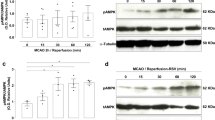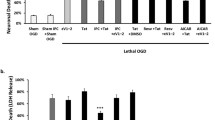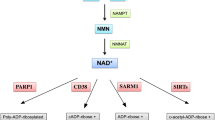Abstract
Neurons require large amounts of energy to support their survival and function, and are therefore susceptible to excitotoxicity, a form of cell death involving bioenergetic stress that may occur in several neurological disorders including stroke and Alzheimer’s disease. Here we studied the roles of NAD+ bioenergetic state, and the NAD+-dependent enzymes SIRT1 and PARP-1, in excitotoxic neuronal death in cultured neurons and in a mouse model of focal ischemic stroke. Excitotoxic activation of NMDA receptors induced a rapid decrease of cellular NAD(P)H levels and mitochondrial membrane potential. Decreased NAD+ levels and poly (ADP-ribose) polymer (PAR) accumulation in nuclei were relatively early events (<4 h) that preceded the appearance of propidium iodide- and TUNEL-positive cells (markers of necrotic cell death and DNA strand breakage, respectively) which became evident by 6 h. Nicotinamide, an NAD+ precursor and an inhibitor of SIRT1 and PARP1, inhibited SIRT1 deacetylase activity without affecting SIRT1 protein levels. NAD+ levels were preserved and PAR accumulation and neuronal death induced by excitotoxic insults were attenuated in nicotinamide-treated cells. Treatment of neurons with the SIRT1 activator resveratrol did not protect them from glutamate/NMDA-induced NAD+ depletion and death. In a mouse model of focal cerebral ischemic stroke, NAD+ levels were decreased in both the contralateral and ipsilateral cortex 6 h after the onset of ischemia. Stroke resulted in dynamic changes of SIRT1 protein and activity levels which varied among brain regions. Administration of nicotinamide (200 mg/kg, i.p.) up to 1 h after the onset of ischemia elevated brain NAD+ levels and reduced ischemic infarct size. Our findings demonstrate that the NAD+ bioenergetic state is critical in determining whether neurons live or die in excitotoxic and ischemic conditions, and suggest a potential therapeutic benefit in stroke of agents that preserve cellular NAD+ levels. Our data further suggest that, SIRT1 is linked to bioenergetic state and stress responses in neurons, and that under conditions of reduced cellular energy levels SIRT1 enzyme activity may consume sufficient NAD+ to nullify any cell survival-promoting effects of its deacetylase action on protein substrates.







Similar content being viewed by others
References
Alcendor, R. R., Gao, S., Zhai, P., Zablocki, D., Holle, E., Yu, X., et al. (2007). Sirt1 regulates aging and resistance to oxidative stress in the heart. Circulation Research, 100, 1512–1521. doi:10.1161/01.RES.0000267723.65696.4a.
Anderson, R. M., Latorre-esteves, M., Neves, A. R., Lavu, S., Medvedik, O., Taylor, C., et al. (2003). Yeast life-span extension by calorie restriction is independent of NAD+ fluctuation. Science, 302, 2124–2126. doi:10.1126/science.1088697.
Ankarcrona, M., Dypbukt, J. M., Bonfoco, E., Zhivotovsky, B., Orrenius, S., Lipton, S. A., et al. (1995). Glutamate-induced neuronal death: A succession of necrosis or apoptosis depending on mitochondrial function. Neuron, 15, 961–973. doi:10.1016/0896-6273(95)90186-8.
Antzoulatos, E. G., & Byrne, J. H. (2004). Learning insights transmitted by glutamate. Trends in Neurosciences, 27, 555–560. doi:10.1016/j.tins.2004.06.009.
Araki, T., Sasaki, Y., & Milbrandt, J. (2004). Increased nuclear NAD+ biosynthesis and SIRT1 activation prevent axonal degeneration. Science, 305, 1010–1013. doi:10.1126/science.1098014.
Beal, M. F. (1992). Mechanisms of excitotoxicity in neurological diseases. The FASEB Journal, 6, 3338–3344.
Belenky, P., Bogan, K. L., & Brenner, C. (2006). NAD+ metabolism in health and disease. Trends in Biochemical Sciences, 32, 12–19. doi:10.1016/j.tibs.2006.11.006.
Bieganowski, P., & Brenner, C. (2004). Discoveries of nicotinamide riboside as a nutrient and conserved NRK genes establish a Preiss-handler independent route to NAD+ in fungi and humans. Cell, 117, 495–502. doi:10.1016/S0092-8674(04)00416-7.
Bitterman, K. J., Anderson, R. M., Cohen, H. Y., Latorre-Esteves, M., & Sinclair, D. A. (2002). Inhibition of silencing and accelerated aging by nicotinamide, a putative negative regulator of yeast Sir2 and human SIRT1. The Journal of Biological Chemistry, 277, 45099–45107. doi:10.1074/jbc.M205670200.
Blander, G., & Guarente, L. (2004). The Sir2 family of protein deacetylases. Annual Review of Biochemistry, 73, 417–435. doi:10.1146/annurev.biochem.73.011303.073651.
Boulares, A. H., Yakovlev, A. G., Ivanova, V., Stoica, B. A., Wang, G., Iyer, S., et al. (1999). Role of poly(ADP-ribose) polymerase (PARP) cleavage in apoptosis: Caspase 3-resistant parp mutant increases rates of apoptosis in transfected cells. The Journal of Biological Chemistry, 274, 22932–22940. doi:10.1074/jbc.274.33.22932.
Brennan, A. M., Connor, J. A., & Shuttleworth, C. W. (2006). NAD(P)H fluorescence transients after synaptic activity in brain slices: predominant role of mitochondrial function. Journal of Cerebral Blood Flow and Metabolism, 26, 1389–1406. doi:10.1038/sj.jcbfm.9600292.
Brunet, A., Sweeney, L. B., Sturgill, J. F., Chua, K. F., Greer, P. L., Lin, Y., et al. (2004). Stress-dependent regulation of FOXO transcription factors by the SIRT1 deacetylase. Science, 303, 2011–2015. doi:10.1126/science.1094637.
Butler, R., & Bates, G. P. (2006). Histone deacetylase inhibitors as therapeutics for polyglutamine disorders. Nature Reviews. Neuroscience, 7, 784–796. doi:10.1038/nrn1989.
Cai, A. L., Zipfel, G. J., & Sheline, C. T. (2006). Zinc neurotoxicity is dependent on intracellular NAD+ levels and the sirtuin pathway. The European Journal of Neuroscience, 24, 2169–2176. doi:10.1111/j.1460-9568.2006.05110.x.
Choi, D. W., & Koh, J. Y. (1998). Zinc and brain injury. Annual Review of Neuroscience, 21, 347–375. doi:10.1146/annurev.neuro.21.1.347.
Clement, M. V., Hirpara, J. L., Chawdhury, S. H., & Pervaiz, S. (1998). Chemopreventive agent resveratrol, a natural product derived from grapes, triggers CD95 signaling-dependent apoptosis in human tumor cells. Blood, 92, 996–1002.
Cohen, H. Y., Miller, C., Bitterman, K. J., Wal, N. R., Hekking, B., Kessler, B., et al. (2004). Calorie restriction promotes mammalian cell survival by inducing the SIRT1 deacetylase. Science, 305, 390–392. doi:10.1126/science.1099196.
Dawson, V. L., & Dawson, T. M. (2004). Deadly conversations: Nuclear-mitochondrial cross-talk. Journal of Bioenergetics and Biomembranes, 36, 287–294. doi:10.1023/B:JOBB.0000041755.22613.8d.
Du, L., Zhang, X., Han, Y. Y., Burke, N. A., Kochanek, P. M., Watkins, S. C., et al. (2003). Intra-mitochondrial poly(ADP-ribosylation) contributes to NAD+ depletion and cell death induced by oxidative stress. The Journal of Biological Chemistry, 278, 18426–18433. doi:10.1074/jbc.M301295200.
Eng, J., Lynch, R. M., & Balaban, R. S. (1989). Nicotinamide adenine dinucleotide fluorescence spectroscopy and imaging of isolated myocytes. Biophysical Journal, 55, 621–630. doi:10.1016/S0006-3495(89)82859-0.
Fabrizio, P., Gattazzo, C., Battistella, L., Wei, M., Cheng, C., McGrew, K., et al. (2005). Sir2 blocks extreme life-span extension. Cell, 18, 655–667. doi:10.1016/j.cell.2005.08.042.
Feng, Y., Paul, I. A., & LeBlanc, M. H. (2006). Nicotinamide reduces hypoxic ischemic brain injury in the newborn rat. Brain Research Bulletin, 69, 117–122. doi:10.1016/j.brainresbull.2005.11.011.
Gao, X., Xu, Y. X., Divine, G., Janakiraman, N., Chapman, R. A., & Gautam, S. C. (2002). Disparate in vitro and in vivo antileukemic effects of resveratrol, a natural polyphenolic compound found in grapes. The Journal of Nutrition, 132, 2076–2081.
Gill, R., Andine, P., Hillerd, L., Persson, L., & Hagberg, H. (1992). The effect of MK-801 on cortical spreading depression in the penumbral zone following focal ischemia in the rat. Journal of Cerebral Blood Flow and Metabolism, 12, 371–379.
Green, K. N., Steffan, J. S., Martinez-Coria, H., Sun, X., Schreiber, S. S., Thompson, L. M., et al. (2008). Nicotinamide restores cognition in Alzheimer’s disease transgenic mice via a mechanism involving sirtuin inhibition and selective reduction of Thr231-phosphotau. Journal of Neuroscience, 28, 11500–11510. doi:10.1523/JNEUROSCI.3203-08.2008.
Greene, J. G., & Greenamyre, J. T. (1996). Bioenergetics and glutamate excitotoxicity. Progress in Neurobiology, 48, 613–634. doi:10.1016/0301-0082(96)00006-8.
Grubisha, O., Smith, B. C., & Denu, J. M. (2005). Small molecule regulation of sir2 protein deacetylase. FEBS, 272, 4607–4616. doi:10.1111/j.1742-4658.2005.04862.x.
Ha, H. C., & Snyder, S. H. (2000). Poly(ADP-ribose) polymerase-1 in the nervous system. Neurobiology of Disease, 7, 225–239. doi:10.1006/nbdi.2000.0324.
Hata, R., Maeda, K., Hermann, D., Mies, G., & Hossmann, K. A. (2000). Dynamics of regional brain metabolism and gene expression after middle cerebral artery occlusion. Journal of Cerebral Blood Flow and Metabolism, 20, 306–315. doi:10.1097/00004647-200002000-00012.
Herceg, Z., & Wang, Z. Q. (1999). Failure of poly(ADP-ribose) polymerase cleavage by caspases leads to induction of necrosis and enhanced apoptosis. Molecular and Cellular Biology, 19, 5124–5133.
Hinz, M., Katsilambros, N., Maier, V., Schatz, H., & Pfeiffer, E. F. (1973). Significance of streptozotocin induced nicotinamide-adenine-dinucleotide (NAD+) degradation in mouse pancreatic islets. FEBS Letters, 30, 225–230. doi:10.1016/0014-5793(73)80656-8.
Hossmann, K. A. (2003). Glutamate hypothesis of stroke. Fortschritte der Neurologie, Psychiatrie, und ihrer Grenzgebiete, 71(Suppl 1), S10. doi:10.1055/s-2003-40500.
Howitz, K. T., Bitterman, K. J., Cohen, H. Y., Lamming, D. W., Lavu, S., & Wood, J. G. (2003). Small molecule activators of sirtuins extend Saccharomyces cerevisiae lifespan. Nature, 425, 191–196. doi:10.1038/nature01960.
Hyun, D. H., Hunt, N. D., Emerson, S. S., Hernandez, J. O., Mattson, M. P., & de Cabo, R. (2007). Up-regulation of plasma membrane-associated redox activities in neuronal cells lacking functional mitochondria. Journal of Neurochemistry, 100, 1364–1374. doi:10.1111/j.1471-4159.2006.04411.x.
Imai, S., Armstrong, C. M., Kaeberlein, M., & Guarente, L. (2000). Transcriptional silencing and longevity protein Sir2 is an NAD+-dependent histone deacetylase. Nature, 403, 795–800. doi:10.1038/35001622.
Kaufmann, S. H., Desnoyers, S., Ottaviano, Y., Davidson, N. E., & Poirier, G. G. (1993). Specific cleavage of poly(ADP-ribose) polymerase: An early marker of chemotherapy-induced apoptosis. Cancer Research, 53, 3976–3985.
Kauppinen, T. M., & Swanson, R. A. (2007). The role of poly(ADP-ribose) polymerase-1 in CNS disease. Neuroscience, 145, 1267–1272. doi:10.1016/j.neuroscience.2006.09.034.
Klaidman, L., Morales, M., Kem, S., Yang, J., Chang, M. L., & Adams, J. D. (2003). Nicotinamide offers multiple protective mechanisms in stroke as a precursor for NAD+, as a PARP inhibitor and by partial restoration of mitochondrial function. Pharmacology, 69, 150–157. doi:10.1159/000072668.
Kobayashi, Y., Furukawa-Hibi, Y., Chen, C., Horio, Y., Isobe, K., Ikeda, K., et al. (2005). SIRT1 is critical regulator of FOXO-mediated transcription in response to oxidative stress. International Journal of Molecular Medicine, 16, 237–243.
Kolthur-Seetharam, U., Dantzer, F., McBurney, M. W., de Murcia, G., & Sassone-Corsi, P. (2006). Control of AIF-mediated cell death by the functional interplay of SIRT1 and PARP-1 in response to DNA damage. Cell Cycle, 5, 873–877.
Landry, J., Sutton, A., Tafrov, S. T., Heller, R. C., Stebbins, J., Pillus, L., et al. (2000). The silencing protein SIR2 and its homologs are NAD+-dependent protein deacetylases. Proceedings of the National Academy of Sciences of the United States of America, 97, 5807–5811. doi:10.1073/pnas.110148297.
Langley, B., Gensert, J. M., Beal, M. F., & Ratan, R. R. (2005). Remodeling chromatin and stress resistance in the central nervous system: histone deacetylase inhibitors as novel and broadly effective neuroprotective agents. Current Drug Targets. CNS Neurological Disorders, 4, 41–50.
Lee, J. B., Grabb, M. C., Zipfel, G. J., & Choi, D. W. (2000). Brain tissue responses to ischemia. The Journal of Clinical Investigation, 106, 723–731. doi:10.1172/JCI11003.
Lisa, F. D., Menabo, R., Canton, M., Baria, M., & Bernardi, P. (2001). Opening of the mitochondrial permeability transition pore causes depletion of mitochondrial and cytosolic NAD+ and is a causative event in the death of myocytesin postischemic reperfusion of the heart. The Journal of Biological Chemistry, 276, 2571–2575. doi:10.1074/jbc.M006825200.
Liu, D., Chan, S. L., de Souza-Pinto, N. C., Slevin, J. R., Wersto, R. P., Zhan, M., et al. (2006). Mitochondrial UCP4 mediates an adaptive shift in energy metabolism and increases the resistance of neurons to metabolic and oxidative stress. Neuromolecular Medicine, 8, 389–414. doi:10.1385/NMM:8:3:389.
Liu, D., Lu, C., Wan, R., Auyeung, W. W., & Mattson, M. P. (2002). Activation of mitochondrial ATP-dependent potassium channels protects neurons against ischemia-induced death by a mechanism involving suppression of Bax translocation and cytochrome C. Journal of Cerebral Blood Flow and Metabolism, 22, 431–433. doi:10.1097/00004647-200204000-00007.
Liu, D., Pitta, M., & Mattson, M. (2008). Preventing NAD+ depletion protects neurons against excitotoxicity: Bioenergetic effects of mild mitochondrial uncoupling, caloric restriction. Annals of the New York Academy of Sciences, 1147, 275–282.
Liu, D., Smith, C. L., Barone, F. C., Ellison, J. A., Lysko, P. G., Li, K., et al. (1999). Astrocytic demise precedes delayed neuronal death in focal ischemic rat brain. Molecular Brain Research, 68, 29–41. doi:10.1016/S0169-328X(99)00063-7.
Matthews, R. T., Ferrante, R. J., Klivenyi, P., Yang, L., Klein, A. M., Mueller, G., et al. (1999). Creatine and cyclocreatine attenuate MPTP neurotoxicity. Experimental Neurology, 157, 142–149. doi:10.1006/exnr.1999.7049.
Matthews, R. T., Yang, L., Jenkins, B. G., Ferrante, R. J., Rosen, B. R., Kaddurah-Daouk, R., et al. (1998). Neuroprotective effects of creatine and cyclocreatine in animal models of Huntington’s disease. Journal of Neuroscience, 18, 156–163.
Mattson, M. P. (2003). Excitotoxic and excitoprotective mechanisms: Abundant targets for the prevention and treatment of neurodegenerative disorders. Neuromolecular Medicine, 3, 65–94. doi:10.1385/NMM:3:2:65.
Mattson, M. P., Barger, S. W., Begley, J. G., & Mark, R. J. (1995). Calcium, free radicals, and excitotoxic neuronal death in primary cell culture. Methods in Cell Biology, 46, 187–216. doi:10.1016/S0091-679X(08)61930-5.
Mattson, M. P., & Liu, D. (2002). Energetics and oxidative stress in synaptic plasticity and neurodegenerative disorders. Neuromolecular Medicine, 2, 215–231. doi:10.1385/NMM:2:2:215.
McBurney, M. W., Yang, X., Jardine, K., Hixon, M., Boekelheide, K., Webb, J. R., et al. (2003). The mammalian SIR2alpha protein has a role in embryogenesis and gametogenesis. Molecular and Cellular Biology, 23, 38–54. doi:10.1128/MCB.23.1.38-54.2003.
Ohsawa, S., & Miura, M. (2006). Caspase-mediated changes in Sir2α during apoptosis. FEBS Letters, 580, 5875–5879. doi:10.1016/j.febslet.2006.09.051.
Pieper, A. A., Blackshaw, S., Clements, E. E., Daniel, J., Brat, D. J., Krug, D. K., et al. (2000). Poly(ADP-ribosyl)ation basally activated by DNA strand breaks reflects glutamate-nitric oxide neurotransmission. Proceedings of the National Academy of Sciences of the United States of America, 97, 1845–1850. doi:10.1073/pnas.97.4.1845.
Pillai, J. B., Isbatan, A., Imai, S., & Gupta, M. P. (2005). Poly(ADP-ribose) polymerase-1-dependent cardiac myocyte cell death during heart failure is mediated by NAD+ depletion and reduced sir2α deacetylase activity. The Journal of Biological Chemistry, 280, 43121–43130. doi:10.1074/jbc.M506162200.
Raval, A. P., Dave, K. R., & Perez-Pinzon, M. A. (2006). Resveratrol mimics ischemic preconditioning in the brain. Journal of Cerebral Blood Flow and Metabolism, 26, 1141–1147.
Rodgers, J. T., Lerin, C., Haas, W., Gygi, S. P., Spiegelman, B. M., & Puigserver, P. (2005). Nutrient control of glucose homeostasis through a complex of PGC-1α and SIRT1. Nature, 434, 113–118. doi:10.1038/nature03354.
Sadanaga-Akiyoshi, F., Yao, H., Tanuma, S., Nakahara, T., Hong, J. S., Ibayashi, S., et al. (2003). Nicotinamide attenuates focal ischemic brain injury in rats: With special reference to changes in nicotinamide and NAD+ levels in ischemic core and penumbra. Neurochemical Research, 28, 1227–1234. doi:10.1023/A:1024236614015.
Sauve, A. A., Moir, R. M., Schramm, V. L., & Willis, I. M. (2005). Chemical activation of sir2-dependent silencing by relief of nicotinamide inhibition. Molecular Cell, 17, 595–601. doi:10.1016/j.molcel.2004.12.032.
Schmidt, M. T., Smith, B. C., Jackson, M. D., & Denu, J. M. (2004). Coenzyme specificity of Sir2 protein deacetylases: Implications for physiological regulation. The Journal of Biological Chemistry, 279, 40122–40129. doi:10.1074/jbc.M407484200.
Schulz, J. B., Henshaw, D. R., Matthews, R. T., & Beal, M. F. (1995). Coenzyme Q10 and nicotinamide and a free radical spin trap protect against MPTP neurotoxicity. Experimental Neurology, 132, 279–283. doi:10.1016/0014-4886(95)90033-0.
Sheline, C. T., Behrens, M. M., & Choi, D. W. (2000). Zinc-induced cortical neuronal death: contribution of energy failure attributable to loss of NAD+ and inhibition of glycolysis. The Journal of Neuroscience, 20, 3139–3146.
Soane, L., Kahraman, S., Kristian, T., & Fiskum, G. (2007). Mechanisms of impaired mitochondrial energy metabolism in acute and chronic neurodegenerative disorders. Journal of Neuroscience Research, 85, 3407–3415. doi:10.1002/jnr.21498.
Sullivan, P. G., Geiger, J. D., Mattson, M. P., & Scheff, S. W. (2000). Dietary supplement creatine protects against traumatic brain injury. Annals of Neurology, 48, 723–729. doi:10.1002/1531-8249(200011)48:5<723::AID-ANA5>3.0.CO;2-W.
Tanner, K. G., Landry, J., Sternglanz, R., & Denu, J. M. (2000). Silent information regulator 2 family of NAD-dependent histone/protein deacetylases generates a unique product, 1-O-acetyl-ADP-ribose. Proceedings of the National Academy of Sciences of the United States of America, 97, 14178–14182. doi:10.1073/pnas.250422697.
Tarnopolsky, M. A., & Beal, M. F. (2001). Potential for creatine and other therapies targeting cellular energy dysfunction in neurological disorders. Annals of Neurology, 49, 561–574. doi:10.1002/ana.1028.
Virag, L., & Szabo, C. (2002). The therapeutic potential of poly (ADP-ribose) polymerase inhibitors. Pharmacological Reviews, 54, 375–429. doi:10.1124/pr.54.3.375.
Winfree, C. J., Baker, C. J., Connoly, E. S., Fiore, A. J., & Solomon, R. A. (1996). Mild hypothermia reduces penumbral glutamate levels in the rat permanent focal cerebral ischemia model. Neurosurgery, 38, 1216–1222. doi:10.1097/00006123-199606000-00034.
Woodley, C. L., & Gupta, N. K. (1971). New enzyme cycling method for determination of oxidized and reduced nicotinamide adenine dinucleotide. Analytical Biochemistry, 43, 341–348.
Yang, J., Klaidman, L. K., Chang, M. L., Kem, S., Sugawara, T., Chan, P., et al. (2002). Nicotinamide therapy protects against both necrosis and apoptosis in a stroke model. Pharmacology, Biochemistry, and Behavior, 73, 901–910. doi:10.1016/S0091-3057(02)00939-5.
Yang, T., & Sauve, A. A. (2006). NAD+ metabolism and sirtuins: Metabolic regulation of protein deacetylation in stress and toxicity. The AAPS Journal, 8, 632–643. doi:10.1208/aapsj080472.
Acknowledgments
We would like to thank Graeme I. Bell for providing us the mouse GLUT3 cDNA clone used for riboprobe preparation and in situ hybridization. This research was supported by the Intramural Research Program of the National Institute on Aging.
Author information
Authors and Affiliations
Corresponding author
Rights and permissions
About this article
Cite this article
Liu, D., Gharavi, R., Pitta, M. et al. Nicotinamide Prevents NAD+ Depletion and Protects Neurons Against Excitotoxicity and Cerebral Ischemia: NAD+ Consumption by SIRT1 may Endanger Energetically Compromised Neurons. Neuromol Med 11, 28–42 (2009). https://doi.org/10.1007/s12017-009-8058-1
Received:
Accepted:
Published:
Issue Date:
DOI: https://doi.org/10.1007/s12017-009-8058-1




